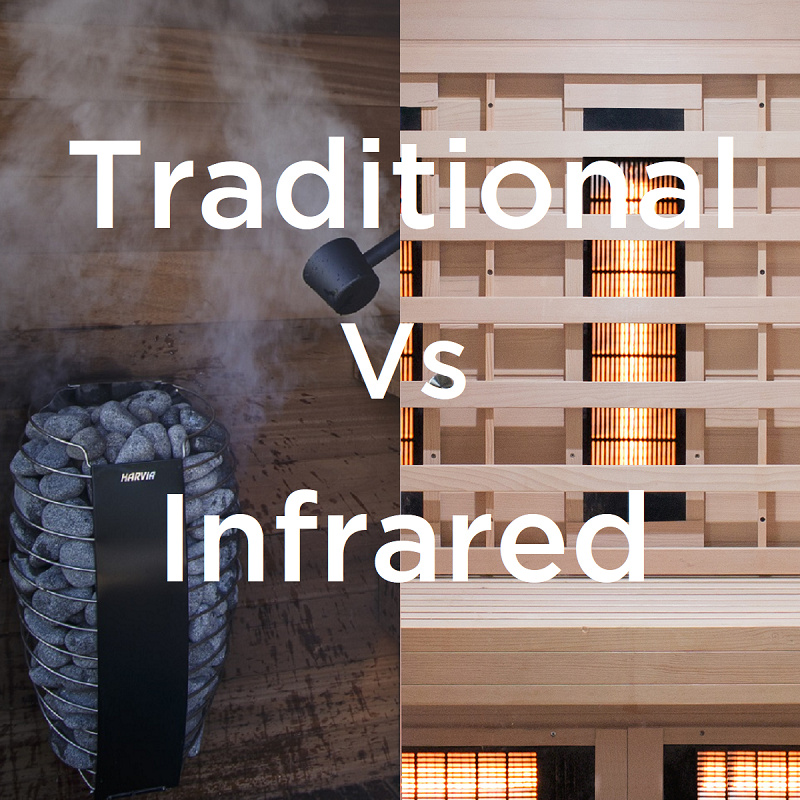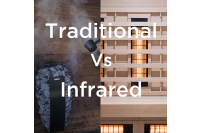
Traditional or Infrared?
How do you want to feel in the sauna? What environment sounds more suited to you? Does one offer an element that suits your lifestyle more? What will you use your sauna for?
This post explores the differences in Traditional and Infrared saunas.
What is at the heart of a sauna?
The heart of the sauna is what powers your sauna.
Traditional saunas, also known as Finnish saunas, conventional saunas or steam saunas can be traced long back in ancient history. At its heart, a sauna heater containing sauna stones aids in the distribution of the heat. The bather controls the environment within the Finnish sauna via a thermostatic temperature control, as well as the ability to pour water over the hot stones to create bursts of steam, which significantly elevates the humidity inside the Finnish sauna room.
Löyly – The Spirit of the Traditional Sauna
The sensation of adding water to the stones, is known by the Finnish as löyly. Directly translated löyly means steam but is also known as the spirit of the sauna, arising from the heater which has always been known as the heart of the sauna.
FAR Infrared – The best of the sunshine rays
Infrared saunas are heated by evenly spaced heaters containing ceramic rods delivering infrared energy. This energy is compared to the warm glow you feel on a sunny day, which comes directly from the sun’s rays. FAR infrared radiant heat is a completely safe form of naturally occurring energy. FAR heat provides many of the health benefits of natural sunlight without any of the dangerous effects of solar radiation.
How hot do you like it?
Traditional Saunas provide the genuine 'hard' heat of a Finnish sauna, with temperatures from 38 °C up to the high heats of 90 °C. Some sauna bathers seek the high heat and humid environment that the traditional sauna heater and stones create. Do you seek the effect of löyly? Add the water to the stones, raise the temperature and create the steam desired. Essential oil can also be added to the heater stones, enhancing your experience further.
Prefer lower temperatures but don’t want to miss out on the health benefits of a sauna?
If a temperature range of 18 to 65 °C sounds more your comfort zone, then an infrared sauna could be for you. This radiant source of heat warms the body directly, rather than having to warm the air first. The temperature may be lower, but the warming radiant heat penetrates more deeply leading to a more intense sweat. This temperature allows for longer sessions and an environment where you can enjoy some entertainment, read a book or listen to music.
Which sauna offers the benefits you seek?
Saunas are known for benefits aiding issues from skin deep to chronic health conditions and even, in recent years, studies have shown regular sauna use can lower the risk of diseases such as dementia and Alzheimer’s.
The Benefits of the Traditional Steam Sauna
Traditional steam sauna opens pores and cleanses the skin through perspiration. They offer relief for sinus and respiratory conditions through the breathing in of the heat and steam. The traditional sauna is also known to increase the metabolic rate, which boosts the immune system and improves cardiovascular circulation. In addition, the high heat of a traditional sauna can relieve the aches and pains caused by arthritis and minor musculoskeletal injuries. The overall affect is one of relaxation and reduced stress.
The Benefits of the Infrared Sauna
FAR infrared saunas induce detoxification of the body by sweating out toxins. This in turn supports the immune system, reduces inflammation and enhances blood flow. Infrared saunas are also associated with lowering the risk of conditions associated with the heart.
NEAR Infrared
Infrared saunas are also available with the addition of NEAR infrared rays which can improve the skin’s appearance by reducing the signs of aging and speeding up the healing of wounds. NEAR infrared saunas can also help to stimulate the body’s production of collagen and improve circulation, which can reduce pain and inflammation, while also enhancing muscle recovery.
Take care
Although both options have many health benefits, it is always recommended that you check the safety advice of the sauna before use and speak with your GP for advice if you have any existing medical conditions.
How much space, time & energy is required?
Traditional Saunas - Time
Traditional saunas take up to 30 minutes to get to temperature. However, the Traditional Sauna Heater options do now include the ability to use an app so that you can switch your sauna on in advance to be at temperature for when you are ready.
Traditional Saunas - Energy
Energy use is dependent on the kW of your heater, which is dependent on the size of the sauna cabin. The larger the space, the higher the energy required to heat your traditional sauna cabin. However, the sessions are usually shorter. The length of time spent in a traditional sauna is usually around 15 minutes, due to its high heat and humidity.
Traditional Saunas - Installation
The traditional sauna heater must be installed by an electrician. The sauna heater stones should be checked and replaced to ensure energy efficiency. An article by Harvia explains the importance of optimising how you use, and when you should replace, your sauna stones here.
Infrared - Time
Infrared saunas are ready to use within minutes of switching on due to the nature of the heat that warms the body directly, not needing to heat the room first.
Infrared - Energy
20% of the Infrared energy is expended on heating the air, whilst 80% directly warms the body. Infrared saunas are low energy appliances, less than 3kW, making them a low-cost option to run.
Infrared Saunas – Installation
Infrared cabins are compact, easy to assemble, plug into a standard household electrical socket and have specially designed bases making them suitable to add to any space in your home.
Quality
When searching for your sauna, you will find a greatly varied price range out there. Each may appear similar. Make sure to check for signs of quality for long term use and insulation for energy efficiency. The material and thickness of the wood, cladding and glass are all elements to compare to ensure you are choosing a product that offers the best value for money.
Summary
FAR Infrared Saunas offer a very cost efficient and easy to maintain alternative to the traditional sauna, whilst still providing all the health benefits. They are becoming more widely used in medical environments and are a fantastic quick turn on and off solution for those who are time starved or require a quick post work-out sauna.
Traditional saunas are generally overall more expensive to purchase, install and run, with more maintenance required. However, they will always have the heart and spirit, providing an authentic sauna experience that many will stand by as being the true sauna.
To conclude
This article is not to say one is better than the other. It is to bring together the comparative aspects and nature that each version offers. Both have their place and answer the different needs of each person for different reasons.
You should get the best personal experience from your sauna, one that optimises your relaxation & sense of wellbeing.
The question to ask yourself is, which sauna is right for me?

